Here are the best heat pumps available. These are standard split system heat pumps from Carrier, Lennox, Rheem, etc.
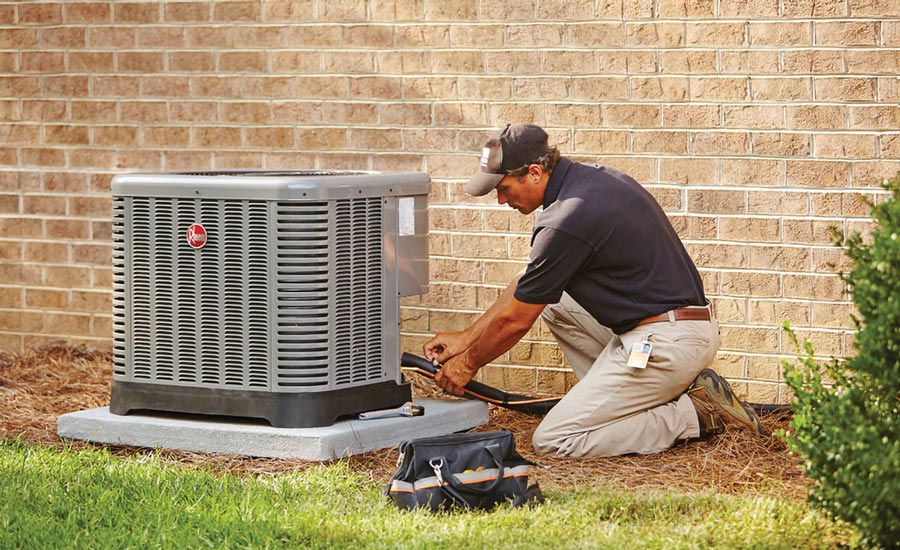 Credits: Achrnews.com
Credits: Achrnews.com
Brand/Unit reviews are followed by a Buying Guide with information about equipment needed and configurations/costs plus common FAQs like, “Do I need an air handler?”
Top 10 Heat Pumps, Prices & Reviews
Variety: We chose the 10 best heat pumps in a range of categories, since every homeowner’s heating and AC preferences are different.
Note on Cost: Inflation woes have hit the heating and air conditioning industry harder than most, and prices are ridiculously high. And we don’t see that changing – no cost correction is coming. So, if you’re in the market for a new heat pump, waiting won’t make it better. And if inflation continues to rise, your dollars will buy less next year.
Two prices are given for each heat pump in the table below:
Heat Pump Only – Installed Cost: These are prices for the outside condensing unit, the indoor evaporator coil, refrigerant lines, and charge plus installation supplies. A new thermostat is often part of the package.
Full System Cost with Air Handler: These prices include the air handler too – the indoor unit with a blower that circulates air through the ductwork. There are times an existing air handler can be used, which saves on cost.
| Heat Pump Model | Installed Cost Heat Pump Only | Installed Cost with Air Handler |
| Trane XL18i | $8,300 – $13,000 | $11,700 – $16,900 |
| Armstrong Air 4SHP20LX | $7,900 – $12,800 | $11,600 – $16,400 |
| Carrier Infinity 24 | $8,800 – $13,400 | $12,200 – $17,300 |
| Ducane 4HP18V | $7,700 – $11,900 | $11,000 – $15,500 |
| Carrier Performance 16 | $7,500 – $11,600 | $10,900 – $15,000 |
| Lennox XP21 | $8,500 – $13,200 | $12,200 – $17,000 |
| Payne 16 | $6,600 – $10,400 | $9,500 – $14,300 |
| Trane XR14 | $5,700 – $9,000 | $8,300 – $12,400 |
| Lennox EL16XP1 | $6,200 – $9,100 | $8,500 – $12,600 |
| Rheem Classic RP15 | $5,500 – $8,600 | $7,800 – $11,900 |
Overall Best Quality and Performance
Trane XL18i 2 Stage Heat Pump
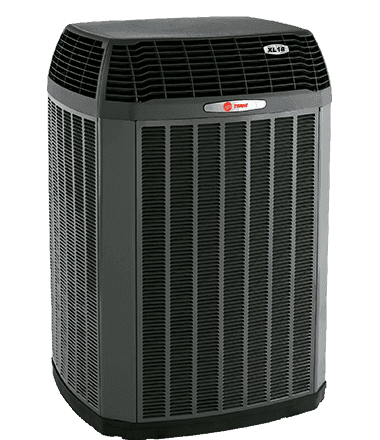
Yes, Trane has a huge marketing budget that has made it a household name. But there’s substance behind the brand motto, “It’s hard to stop a Trane.” But stopping one is not impossible, lol.
Trane tops most lists produced by independent testing agencies like Consumer Reports, where it leads the way in both Predicted Reliability (the pros’ perspective) and Owner Satisfaction (the consumers’ view).
Heat Pump Only – Installed Cost: $8,300 to $13,000. Yes, sticker shock! This price comes directly from Trane’s own pricing page and is verified by current invoices from homeowners who have had this Trane heat pump installed.
We got an estimate from a Trane dealer in Arizona this week for the variable capacity version of this unit, the XV18: It costs $9,600 to $14,000 depending on size and installation factors!
Full System Cost with Air Handler: $11,700 to $16,900
Top Efficiency: 18 SEER; 9.50 HSPF. SEER is cooling efficiency. HSPF is heating efficiency. Higher is better. The highest SEER available is 24. For HSPF, it is 13.
Stages & Features: 2-stage heating and air conditioning. The heat pump is offered in 2-, 3-, 4- and 5-ton sizes, or 24,000 to 60,000 BTU. ]
Trane’s Climatuff compressor is considered one of the most durable, and the unique Spine Fin outdoor coil quickly sheds heat during AC cycles.
Pros: Trane uses quality parts. The compressor and coils in these units have been used for more than 15 years and have a track record of reliability.
Trane requires its equipment to be installed by experienced technicians with advanced training and certifications, reducing the potential for human error, which is a major source of mechanical failure in HVAC systems.
Cons: Trane prices have risen more than costs for most brands. This is an expensive unit to have installed and to repair, if needed. The noise level of 72-74 decibels is higher than variable capacity and a few other 2-stage heat pumps.
Warranty: 12 years on the compressor; 10 years on all other parts. This is slightly better than the average of 10/10.
Best Return on Investment
You will get your money’s worth in regions of the country where the AC season is long, hot and perhaps humid, too.
Yes, Trane makes variable capacity heat pumps that a lot of dealers push in hot climates, the XV20i at 20 SEER and the XV18 at 18 SEER. But they cost a lot more, and you probably won’t recoup the extra cost through lower energy bills over the unit’s life.
If you prefer the enhanced indoor climate control and efficiency of variable capacity heating and AC, see the Armstrong Air variable capacity heat pump – our runner up for top place. It costs less = it’s a better value.
Alternate – Best Quality and Performance
Armstrong Air 4SHP20LX Heat Pump
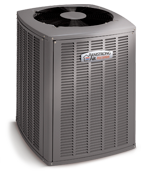
Armstrong doesn’t have the name recognition of Trane, but the quality is on par while value and return on investment – what you get for your money – is better.
Note that the price of this variable capacity heat pump is competitive with Trane’s 2-stage heat pump above.
This unit delivers high efficiency plus excellent temperature balance and humidity control.
Heat Pump Only – Installed Cost: $7,900 to $12,800.
Full System Cost with Air Handler: $11,600 to $16,400
Top Efficiency: 20 SEER; 10 HSPF
Stages & Features: A variable capacity AC like this one, with an inverter-driven compressor, modulates its capacity or speed to precisely meet the demand for heat or cooling. The Armstrong 4SHP20LX varies between 40 and 100 percent of capacity.
The compatible Comfort Sync thermostat and app offer WiFi control from anywhere, a real asset for convenience and lowering energy use/cost.
Pros: The variable capacity, inverter-style compressor like those used in mini split systems offers premium climate control, keeps temperature very balanced and maximizes dehumidification in humid weather. Noise level is low at 59 to 63 dBA.
Cons: Variable capacity systems generally have higher installation and repair costs. Armstrong Air doesn’t have as wide a network of dealers, so finding this unit in some areas could be a challenge. But note below, it is available from Ducane and Allied Air dealers, too.
Warranty: 10 years on all parts.
Best Return on Investment
If you want the enhanced efficiency and climate control of variable capacity heating and cooling without spending “Trane or Lennox money,” consider Armstrong Air.
Most Efficient Variable Capacity
Carrier Infinity 24 Heat Pump 25VNA4
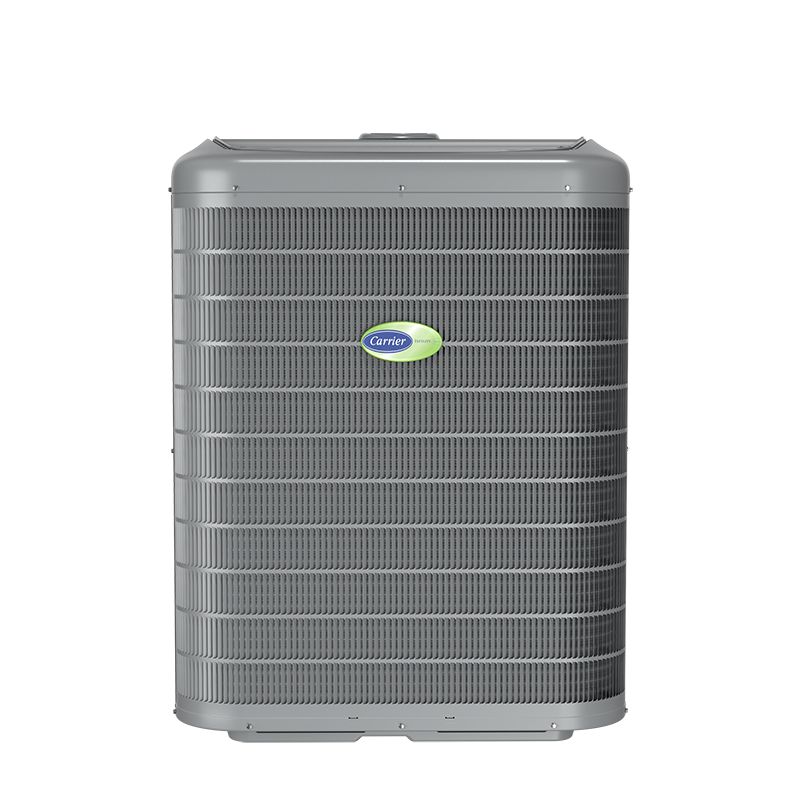 Introduced recently, the Infinity 24 recaptured top place in efficiency from the Lennox SLP25PV with 24 SEER/11.8 HSPF.
Introduced recently, the Infinity 24 recaptured top place in efficiency from the Lennox SLP25PV with 24 SEER/11.8 HSPF.
While this model is new, Carrier’s “Greenspeed” variable capacity technology at the heart of this unit has been perfected during the last 15 years, so there are no “new model” concerns with the Infinity 24 heat pump.
Heat Pump Only – Installed Cost: $8,800 – $13,400
Full System Cost with Air Handler: $12,200 to $17,300
Top Efficiency: 24 SEER; 13.0 HSPF
Stages & Features: The variable capacity compressor operates between 25 and 100 percent, modulating at increments of about 1 percent. This ensures that it will run as low as possible while still keeping up with the cooling or heating demand.
For example, on an 80-degree day, the unit will coast along at less than 50 percent capacity to keep your home cool. When temperatures soar into the 90s or above 100, it will ramp up to a higher capacity to meet the demand.
Pros: Optimally efficient heating and air conditioning plus superior indoor comfort compared with single stage and two stage heat pumps.
The 13 HSPF heater efficiency is easily the highest available. This is a quiet unit that runs at 51 to 55 decibels.
Cons: Variable capacity systems are called “communicating” systems because the condensing unit and thermostat “talk” to one another, rather than the thermostat simply sending direction to the condensing unit.
As a result, they can be notoriously hard to set up for an inexperienced installer.
While Carrier generally requires factory-certified technicians to install its products, sometimes problems occur.
The results, and this system isn’t immune from them, are error codes that stop the system from working until a knowledgeable technician can sort out the issue. — This is a rare issue with Carrier, but it emphasizes the need to hire contractor that will send their most experienced installer to do the job.
Warranty: 10 years on all parts. If the compressor fails in the first decade, Carrier will replace the entire condensing unit, not just the part.
Identical Models: Bryant Evolution Extreme 24 heat pump.
Best Return on Investment
From a strictly cost perspective, this unit makes the most sense in hot zones of the southeast to the southwest and in cold – but not extreme – regions of the north where the best-in-class 13 HSPF will certainly lower your heating bills.
From a comfort angle, this heat pump will appeal to you if you want precision temperature balance and pleasant, dry summer air indoors – and are willing to pay more to enjoy it.
Best Value Variable Capacity
Ducane 4HP18V LYNX 18 Heat Pump
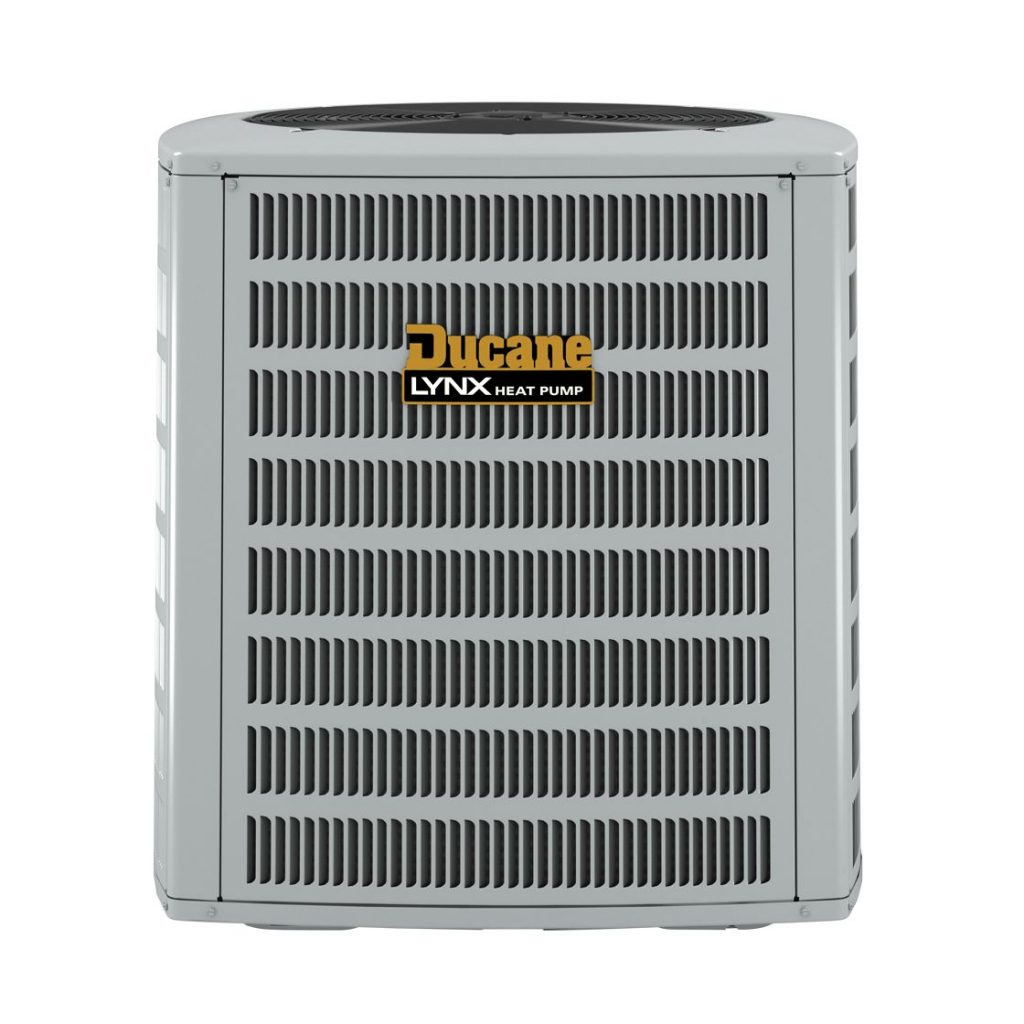
This unit is less expensive than comparable models from Trane, Lennox, and Carrier, but the quality is comparable. That equals excellent value – return on investment.
Ducane, Allied Air and Armstrong Air are Allied Air Enterprises brands, a company owned by Lennox.
Some models among the three are identical, and they all share technology with parent company Lennox. They are priced lower than Lennox to be marketed to a wider range of customers, though the quality of the top heat pumps is very good.
Heat Pump Only – Installed Cost: $7,700 to $11,900
Full System Cost with Air Handler: $11,000 to $15,500
Top Efficiency: 18 SEER; 10.0 HSPF
Stages & Features: Variable stages between 40 and 100 percent. The unit is available in 2-, 3-, 4- and 5-ton sizes. It has dual fuel capacity – meaning it can be installed in a system with a gas furnace, usually an option where extreme winter cold can make heat pumps ineffective.
Pros: Premium indoor climate control. Good SEER and excellent HSPF ratings. The quality is well above average.
Cons: In terms of SEER, there are quite a few two stage heat pumps rated 18 SEER – and many cost less.
Most variable heat pumps are more efficient than this one. Noise level is OK for a modulating unit – from 64 to 71 decibels. There are quieter variable capacity units.
Warranty: 10 years on everything.
Identical Models: Allied Air 4HP18V LYNX 18
Best Return on Investment
This unit is designed for warm, humid climates without consistent, extreme heat or cold. It is recommended for you if you want an affordable variable capacity unit to get the enhanced indoor comfort it offers.
Best 2-Stage
Carrier Performance 16 Heat Pump 25HCB6
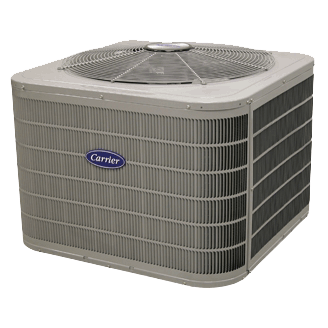 Carrier quality and dependability meet Energy Star efficiency in this highly rated unit. The brand requires installation by certified, experienced technicians, and that produces better dependability.
Carrier quality and dependability meet Energy Star efficiency in this highly rated unit. The brand requires installation by certified, experienced technicians, and that produces better dependability.
Heat Pump Only – Installed Cost: $7,500 to $11,600
Full System Cost with Air Handler: $10,900 to $15,000
Top Efficiency: 17 SEER; 9.5 HSPF. Some Carrier literature claims 18 SEER as the top efficiency.
Stages & Features: Two stages – 70% and 100% capacity. Carrier’s patented microtube coil is compact and space-saving plus proven reliable, as is the Carrier compressor.
Carrier recommends the ecobee3 lite WiFi thermostat designed specifically for use with Carrier equipment for this heat pump.
Pros: Premium quality, better efficiency, and climate control than single-stage heat pumps. Standard and WiFi thermostats (like ecobee) can be used. Works with an air handler or gas furnace.
Cons: Carrier is a premium brand with good dependability, but that comes at a higher cost. The lowest noise level is 70dB, which is a little louder than some comparable units.
Warranty: 10 years on all parts – no unit replacement warranty, as with the variable capacity model above.
Identical Models: Bryant Preferred 226A heat pump
Best Return on Investment
With 2 stages of heating and air conditioning and 17 SEER/9.5 HSPF, this unit gives the best value for the money in all but the hottest and coldest climates.
Most Efficient 2 Stage
Lennox XP 21 Heat Pump
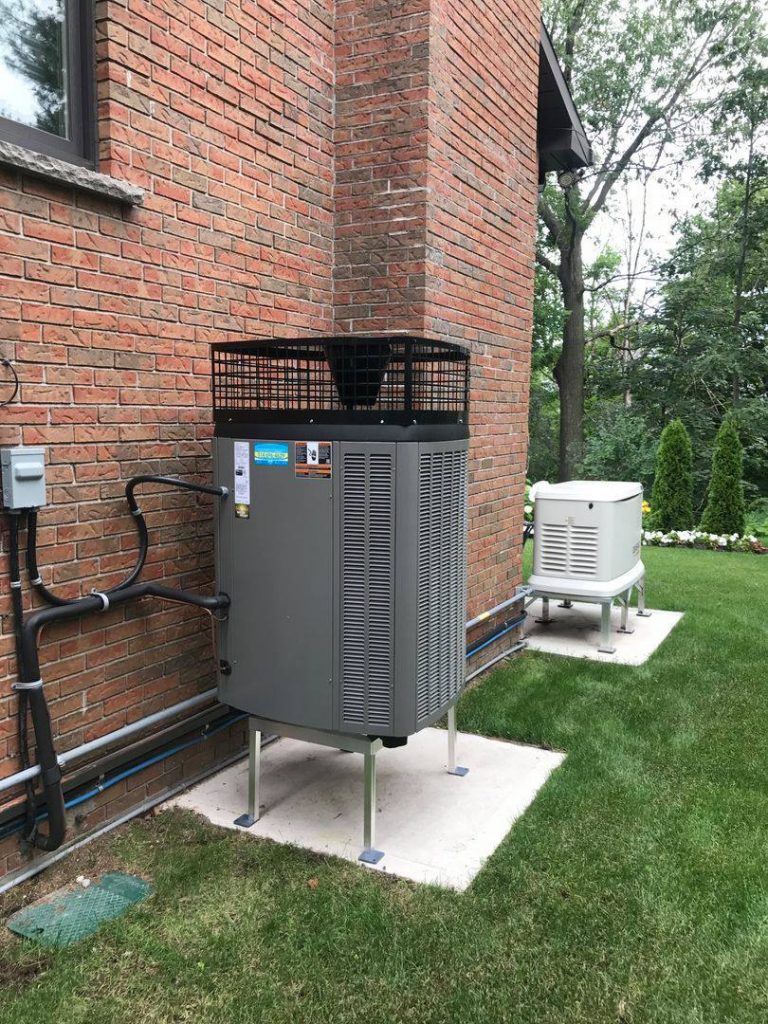 Credits: JCD Refrigeration Inc.
Credits: JCD Refrigeration Inc.
Lennox has positioned itself as a leader in HVAC efficiency, usually vying with Carrier for the top spot in heat pumps and ACs. Several of its units, including the XP21, make Energy Star’s Most Efficient list every year.
Notably, Lennox has also improved quality in the last 5-8 years after a couple decades of relying on reputation and not dependable products.
Heat Pump Only – Installed Cost: $8,500 to $13,200
Full System Cost with Air Handler: $12,200 to $17,000
Top Efficiency: 19.2 SEER; 9.8 HSPF
Stages & Features: 2 heating and AC stages, and the unit runs on the low stage as much as 80% of the time. This allows it to keep up with the thermostat demand while reducing energy use.
Lennox’s proprietary Quantum coil is an aluminum alloy that enhances corrosion-resistance. It’s a dual fuel heat pump.
Pros: The efficiency is best-in-category. Quality is very good. This unit runs quietly – as low as 67 decibels.
Cons: Lennox has periodic supply chain issues, and this can delay repairs.
Warranty: 10 years on all parts.
Best Return on Investment
If you appreciate the benefit of reducing energy consumption and like to see lower monthly electricity costs, this Lennox heat pump is a good fit. We wouldn’t hesitate to suggest it for all but the coldest climates.
Best Value 2 Stage
Payne Two-Stage Heat Pump 16 PH16NA
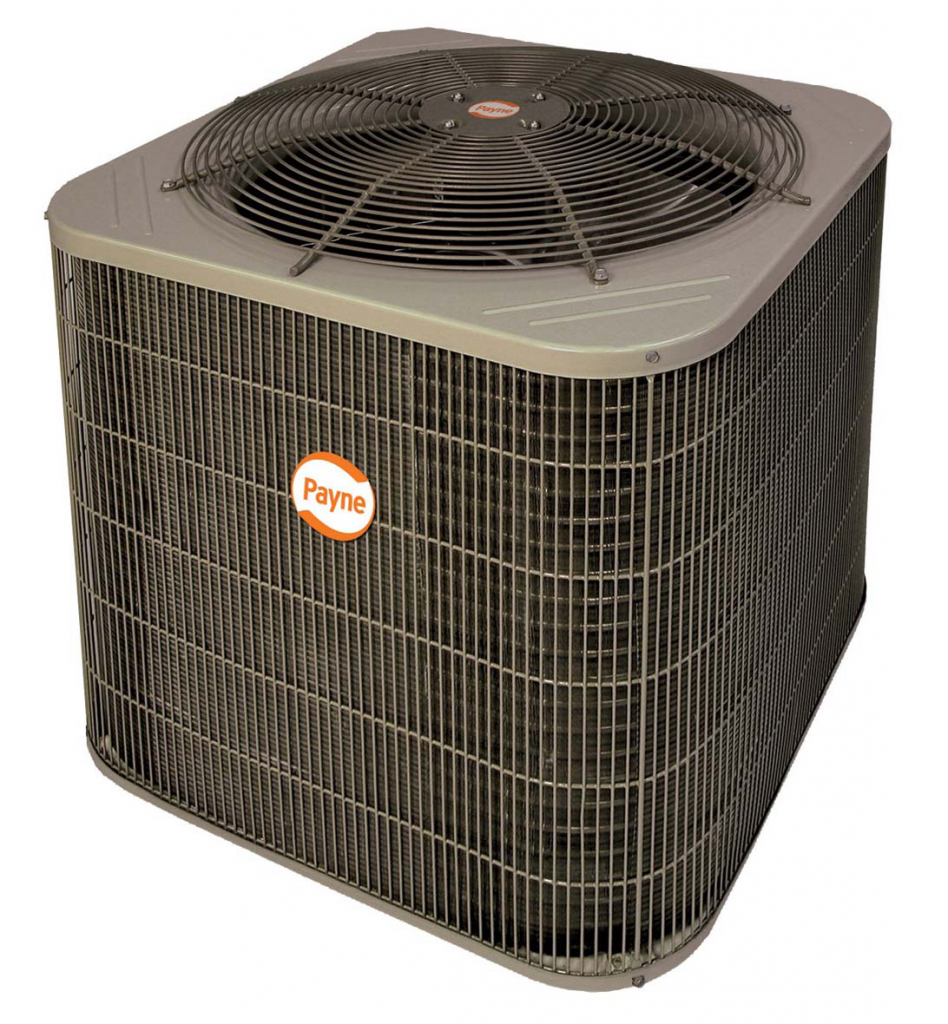
Payne is a Carrier Corporation company and is widely acknowledged as one of the most reliable brands available. There are just 4 heat pumps in the Payne lineup, but they are identical to Carrier models. However, Payne sells them for less. This gives dealers that sell both brands the opportunity to appeal to a wider spectrum of homeowners.
Heat Pump Only – Installed Cost: $6,600 to $10,400
Full System Cost with Air Handler: $9,500 to $14,300
Top Efficiency: 17 SEER; 9.5 HSPF.
Stages & Features: Two stages of heating and air conditioning. Powder-coated galvanized steel cabinet resists corrosion.
Pros: You get more quality and value for your money with Payne compared with Carrier.
Cons: Payne units can be installed by any licensed HVAC technician, not just a Carrier-certified tech.
Therefore, do your due diligence to hire company that will send a well-trained installer to your home. Consider asking about their certifications including what level, if any, of NATE certification they have.
Warranty: A comprehensive 10-year warranty.
Identical Models: Carrier Performance 16 Heat Pump 25HCB6. We listed this model separately because of the cost difference and the potential issue with who you hire for installation.
Best Return on Investment
You will save money upfront with this unit compared to the identical Carrier heat pump. And in the long-term, your ROI will be protected if you hire a skilled, experienced installer. If you choose “just anyone,” the value you gained with Payne might be lost.
Best 1-Stage
Trane XR14 Heat Pump
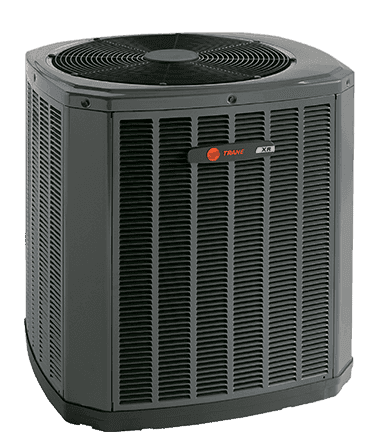
This is Trane’s best single stage heat pump. In fact, it is Trane’s highest-rated heat pump for customer satisfaction!
One of the nice things about a single stage unit is that upfront cost and repair costs are lower than for higher-performance models.
Heat Pump Only – Installed Cost: $5,700 to $9,000
Full System Cost with Air Handler: $8,300 to $12,400
Top Efficiency: 14 SEER; 8.2 HSPF.
Stages & Features: 1 stage heating and AC. This is a basic model in terms of features, though it is dual fuel.
Pros: Lower cost, high quality.
Cons: Efficiency and indoor climate control suffer with a single stage unit compared to staged/variable heating and air conditioning. In a warm/hot climate, cost savings on equipment will be eaten up by high electric costs for AC.
Warranty: 10 years on all parts. Trane warranties are the same for all models unlike some brands (Lennox, Heil, and many others) that reduce warranty length on more affordable heat pumps.
Best Return on Investment
The best value with this unit is realized in moderate climates where high efficiency isn’t necessary. The lower efficiency makes it a bad investment in climates with extreme heat or cold. Potential buyers in extreme climates who check details won’t be impressed either.
Most Efficient 1 Stage
Lennox EL16XP1 Heat Pump
Impressive efficiency is combined with decent quality and a midrange price.
Heat Pump Only – Installed Cost: $6,200 – $9,100
Full System Cost with Air Handler: $8,500 to $12,600
Top Efficiency: 17 see; 9.8 HSPF.
Stages & Features: The 1 stage compressor runs at full capacity whenever heating or cooling. The Quantum aluminum alloy coil is used in this heat pump.
Pros: It is an energy miser, so it will reduce energy use and cost in most heat pump replacement jobs.
Cons: Single stage models like the Lennox EL16XP1 don’t remove as much humidity as two stage and variable capacity heat pumps. So, humid rooms can feel a little clammy instead of dry and comfortable. This heat pump isn’t a good choice for humid regions in the south and east.
Warranty: 10 years on the compressor; 5 years on other parts.
Best Return on Investment
This is a good choice for a warm but fairly dry climate like those found in the western US.
Best Value 1-Stage
Rheem Classic Series RP15 Heat Pump
 Credits: Achrnews.com
Credits: Achrnews.com
Rheem has consistently made good-quality heat pumps like this one at reasonable cost. This isn’t the cheapest single stage heat pump – it’s the best one at a fair price. We’d pick a Goodman heat pump if this was about cheap heat pumps at affordable prices.
Heat Pump Only – Installed Cost: $5,500 to $8,600
Full System Cost with Air Handler: $7,800 to $11,900
Top Efficiency: 15 SEER; 9.0 HSPF.
Stages & Features: Single stage heating and air conditioning. The unit itself has few notable features. It can be paired with a WiFi thermostat for convenience.
Pros: This unit is a good value, a combination of good quality and fair price. It is produced in 12 models from 1.5 to 5.0 tons, so your HVAC technician will be able to custom-fit the right model to your home’s heating and cooling requirements.
Cons: With just 15 SEER cooling efficiency, it isn’t a good fit for warm/hot climates where it would use a costly amount of electricity.
Warranty: 10 years on all parts.
Identical Models: Ruud RP15
Best Return on Investment
This unit makes the best sense in moderate to cool climates. Avoid it for AC where the cooling season is long and warm – and in climates where freezing weather is common and if it would be the sole heating source.
Heat Pump Buying Guide & FAQs
Let’s start with pricing scenarios and factors, since the price ranges are fairly wide.
Pricing Scenarios
The Heat Pump Price Table above gives two price ranges. Here they are with an explanation of what is included.
Installed Cost Heat Pump Only is the cost of installing the condensing unit outside the house, the evaporator coil in the furnace or air handler plus refrigerant lines and a refrigerant charge. A new outside shutoff panel is part of most estimates.
Installed Cost with Air Handler includes the above plus the air handler installed indoors or in the garage.
What else is included in the prices?
Both cost ranges include permits plus removal and disposal of old equipment that won’t be reused. Minor sheet metal adjustments to the plenum and cold air return where they connect to the air handler are part of most heat pump system estimates.
What is not included in the prices?
Ductwork and adding an electrical circuit and wiring. Expect ductwork cost estimates of $1,750 to $2,500 for a 2,000 square foot house. A circuit and wiring
Price Factors
These are the major indicators of whether your cost will be in the low, middle, or upper end of the cost spectrum for each unit:
Size: Depending on installation factors and the pricing of dealers in your area, the price difference between a 1.5-ton heat pump and a 5.0-ton model is $2,500 to $3,300.
For example, we priced the Trane XR14 in Phoenix, and the costs for the various size complete systems (heat pump/air handler/all supplies) was: 1.5 tons = $8,800 / 2.0 tons = $9,200 / 2.5 tons = $9,700 / 3.0 tons = $10,400 / 4.0 tons = $11,300 / 5.0 tons = $12,000. That’s a total range of $3,200.
Where Installed: Installation in a garage is easiest. A first-floor utility closet or a walkout basement increases cost by $100 to $200. Basement (non-walkout) or attic installation raises installation another $200 or so.
Cost of Living: We just said the cost difference in any area or zip code is $2,500 to $3,300. When you factor cost of living, the range increases to $3,300 to $5,000 for sizes from 1.5 to 5 tons.
To see the difference of just one size heat pump, the 3.0-ton Trane XR14 system that cost $10,400 in Phoenix costs $9,300 in Oklahoma City and $11,200 in Boston.
Do I need an air handler?
Yes. To be clear, all heat pump systems need an air handler. It houses the indoor coil in most systems and is connected to the ductwork. Plus, it has a blower that circulates air through ductwork, pulling untreated air into the system and pushing out treated air into the rooms of your home. It is essential equipment.
When don’t you need a new air handler?
The old air handler is OK: In about 15% to 20% of installations, an old air handler is newer, in good condition and compatible with the new heat pump. So, it can be used instead of replaced.
The home has a good furnace: In another small percentage of jobs, the home has a gas furnace, but the homeowner wants to add a heat pump for more efficient heating when temperatures are above freezing. So, the heat pump equipment is added.
The furnace remains as the air handler when the heat pump is heating or cooling. And the furnace takes over the heating task when outside temperature drops into the freezing range where heat pumps lose efficiency. These are called dual fuel heat pump systems.
How much does the air handler cost?
Adding an air handler to the project costs an additional $2,700 to $4,500 tops depending on the brand, airflow capacity and whether the blower is variable speed.
I’m replacing a boiler heating system. What heat pump equipment do I need?
All of it – the outside unit plus an air handler indoors with an evaporator coil, refrigerant lines and a refrigerant charge.
Plus, if the home doesn’t have ductwork, which is common in homes with boiler systems, then it will have to be added. Doing so is really only cost-feasible in single-story homes where the entirety of the ductwork can be run in the attic or in a basement.
In any existing home without ductwork, replacing a boiler system with a mini split heat pump system rather than a conventional heat pump system is well worth considering.
What climate factors play a role in buying a heat pump?
This is a great topic and has been covered in detail in our AC Buying Guide for Different Climates. It is completely applicable to heat pumps as well.
In short, here are a few key factors:
Warm climates: The warmer the climate, the higher the efficiency of the system should be. It will cost more, but the higher cost will be recovered through lower energy costs.
Humid climates: A two stage or variable capacity heat pump will remove more humidity when in AC mode than a single stage system. And it will make the air more comfortable at a higher temperature. In other words, air at 78F with 35% relative humidity is more comfortable than 72F air with 60% humidity.
Freezing climates: If freezes are infrequent, then a heat pump system is OK. Where sub-freezing temperatures are common, then it makes sense to either go with a dual fuel heat pump system that has a gas furnace in place of the air handler or go with a gas furnace/AC split system and skip the heat pump.
What are the pros and cons of variable capacity heat pumps?
The advantages are higher energy efficiency, better dehumidification during air conditioning and precise temperature balance without swings.
The disadvantages are higher equipment cost, more expensive repairs, and the fact that sometimes it is difficult to get these “communicating systems” to talk to one another and stay talking. When they don’t communicate, the system shuts down.
Most of the communicating issues occur with poor installation, so be sure that the installer sent to your home has plenty of experience with communicating/variable capacity systems – or find another HVAC company!
Note – the variable capacity heat pumps selected in this 10 Best Heat Pumps List are considered among the most reliable communicating systems available. Failure to communicate is rare and easily remedied by an experienced technician when it happens.
Are Goodman heat pumps any good?
They’re better than they were before Daikin bought the brand and started overhauling the lineup. Consumer Reports rates Goodman heat pumps currently in use near the bottom of the pile.
New and improved Goodman heat pumps have only been available for 3-5 years depending on the model. That’s not long enough to have a track record of reliability – or to change Goodman’s “cheap” reputation.